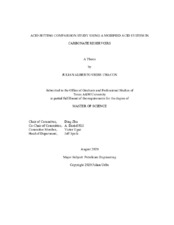| dc.description.abstract | In carbonate reservoirs, wells are typically stimulated by injecting acid into the formation. The injected acid reacts and dissolves the formation minerals, creating high-conductive flow paths, also known as wormholes. HCl is the most commonly used acid system in well stimulation in these types of reservoirs. However, at low injection rates, HCl results in poor wormholing efficiency. These low injection rates are required for formations with low breakdown pressures, and for stimulating long horizontal wells. Another challenge of acidizing horizontal wells is the even acid distribution along extended laterals. A mechanical diversion technique has shown promising results in enhancing flow distribution along extended laterals by using small nozzles that adjust the completion’s local pressure drop to the formation properties. This type of completion causes the injected acid to be jetted into the formation. It has been experimentally demonstrated that acid jetting results in a bulb-like dissolution structure, known as cavity, and also, wormholes are propagated from the cavity face into the rock. However, the high reaction rates of HCl and carbonate formations at low injection rates limit the wormholing efficiency of the acidizing treatments, even when the acid is properly distributed along the lateral. This study presents experimental results of a modified acid system with controlled reaction rates under jetting conditions at various injection rates.
Linear core-flood jetting tests were conducted at a temperature of 190 °F, and various interstitial and jetting velocity conditions. The distance from the nozzle and the rock sample was maintained invariably for all the tests. A returning line allows the acid not flowing through the rock to flow back to a waste tank; this permitted the matrix flux is constant. Indiana limestone cores of 4-in in diameter and 16-in in length were used. The permeability and porosity were measured, and their values ranged between 1-3 mD and 12-18%, respectively. A modified acid system and 15% HCl were evaluated for wormhole efficiency. Additionally, the modified acid system was used to investigate the effect of jetting velocity, nozzle size, and jetting time on the dissolution structures.
The experimental results indicate that compared to 15% HCl, the modified acid improves cavity growth control and enhances wormhole propagation rates. Longer wormholes and smaller cavities were achieved with the modified acid at similar testing conditions as 15% HCl; this effect is more pronounced as interstitial velocity and jetting velocity increase. Overall, the modified acid matched HCl results at low jetting velocity and out-performed HCl as jetting velocity increased. | en |


